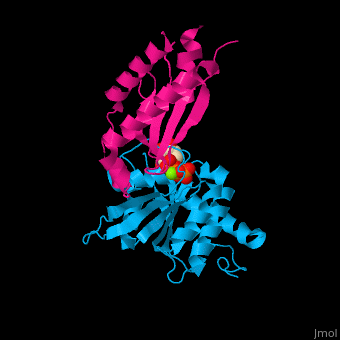Signal recognition particle receptor: Difference between revisions
Jump to navigation
Jump to search
No edit summary |
No edit summary |
||
| Line 1: | Line 1: | ||
< | <StructureSection load='' size='450' side='right' scene='48/485587/Cv/1' caption='Human SRPR α (magenta) and β subunit (deepskyblue) complex with GTP and Mg+2 (green) ion [[2fh5]]'> | ||
'''Signal recognition particle receptor''' (SRPR) is associated with the endoplasmic reticulum. SRPR is a receptor for the [[Signal recognition particle protein|signal recognition particle (SRP)]]. SRPR is a heterodimer with α and β subunits which contain a GTP-binding domain. SRPR α subunit binds to SRP54 subunit of SRP complex. SRPR β subunit is a transmembrane GTPase. The bacterial SRPR is called '''FtsY'''. | '''Signal recognition particle receptor''' (SRPR) is associated with the endoplasmic reticulum. SRPR is a receptor for the [[Signal recognition particle protein|signal recognition particle (SRP)]]. SRPR is a heterodimer with α and β subunits which contain a GTP-binding domain. SRPR α subunit binds to SRP54 subunit of SRP complex. SRPR β subunit is a transmembrane GTPase. The bacterial SRPR is called '''FtsY'''. | ||
Revision as of 18:55, 10 July 2018
Signal recognition particle receptor (SRPR) is associated with the endoplasmic reticulum. SRPR is a receptor for the signal recognition particle (SRP). SRPR is a heterodimer with α and β subunits which contain a GTP-binding domain. SRPR α subunit binds to SRP54 subunit of SRP complex. SRPR β subunit is a transmembrane GTPase. The bacterial SRPR is called FtsY.
|
| ||||||||||
3D structures of signal recognition particle receptor3D structures of signal recognition particle receptor
Updated on 10-July-2018
